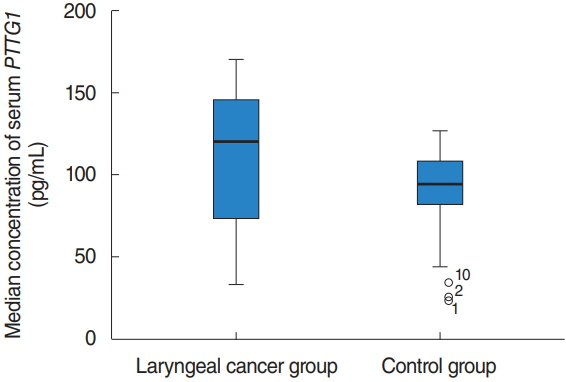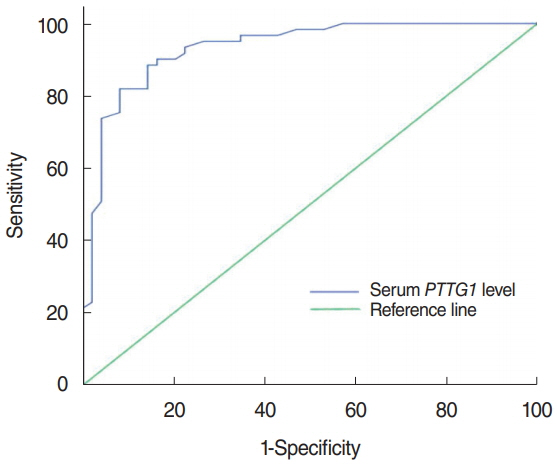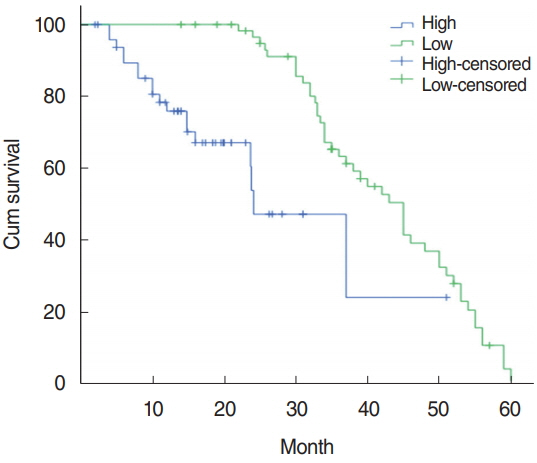Clin Exp Otorhinolaryngol.
2020 Feb;13(1):64-68. 10.21053/ceo.2019.00395.
Expression of Serum PTTG1 in Laryngeal Carcinoma and Its Correlation to Prognosis
- Affiliations
-
- 1Department of Otorhinolaryngology, Affiliated Hospital of Weifang Medical University, Weifang, China
- 2Department of Plastic Surgery, Plastic Surgery Hospital of Weifang Medical University, Weifang, China
- 3Department of Network Information Center, Weifang Medical University, Weifang, China
- KMID: 2501300
- DOI: http://doi.org/10.21053/ceo.2019.00395
Abstract
Objectives
. The purpose of this study was to investigate serum pituitary tumor transforming gene (PTTG1) expression in laryngeal carcinoma and its relationship with the clinical pathological characteristics and prognosis.
Methods
. Expression of serum PTTG1 was measured by enzyme-linked immunosorbent assay in 110 patients with laryngeal carcinoma and 60 patients with vocal cord polyps. Expression of the serum PTTG1 levels relationship with the clinicopathological characteristics and prognosis were analyzed.
Results
. In laryngeal carcinoma patients’ serum, the PTTG1 median concentration was 141.43 pg/mL (interquartile range [IQR], 111.387 to 160.837 pg/mL), significantly higher than that of the vocal cord polyp group of 94.01 pg/mL (IQR, 81.26 to 108.59 pg/mL), and the difference was statistically significant (z=–6.715, P<0.001). PTTG1 expression with lymph node metastasis, clinical stage, and patients with laryngeal carcinoma was significantly correlated with the tumor differentiation degree (P<0.05). The total survival rate of the PTTG1 high expression group was significantly lower than the low expression group, and the difference of total survival time of the two groups was statistically significant (P<0.001).
Conclusion
. The PTTG1 expression level can be used as an index for evaluating prognosis of laryngeal cancer. High PTTG1 expression is one of the factors of poor prognosis of laryngeal carcinoma patients.
Keyword
Figure
Reference
-
1. Siegel R, Naishadham D, Jemal A. Cancer statistics, 2012. CA Cancer J Clin. 2012; Jan-Feb. 62(1):10–29.
Article2. Rudolph E, Dyckhoff G, Becher H, Dietz A, Ramroth H. Effects of tumour stage, comorbidity and therapy on survival of laryngeal cancer patients: a systematic review and a meta-analysis. Eur Arch Otorhinolaryngol. 2011; Feb. 268(2):165–79.
Article3. Siegel R, Ma J, Zou Z, Jemal A. Cancer statistics, 2014. CA Cancer J Clin. 2014; Jan-Feb. 64(1):9–29.
Article4. Hoffman HT, Porter K, Karnell LH, Cooper JS, Weber RS, Langer CJ, et al. Laryngeal cancer in the United States: changes in demographics, patterns of care, and survival. Laryngoscope. 2006; Sep. 116(9 Pt 2 Suppl 111):1–13.
Article5. Hanahan D, Weinberg RA. The hallmarks of cancer. Cell. 2000; Jan. 100(1):57–70.
Article6. Smee RI, De-loyde KJ, Broadley K, Williams JR. Prognostic factors for supraglottic laryngeal carcinoma: importance of the unfit patient. Head Neck. 2013; Jul. 35(7):949–58.
Article7. Pei L, Melmed S. Isolation and characterization of a pituitary tumor-transforming gene (PTTG). Mol Endocrinol. 1997; Apr. 11(4):433–41.
Article8. Li H, Yin C, Zhang B, Sun Y, Shi L, Liu N, et al. PTTG1 promotes migration and invasion of human non-small cell lung cancer cells and is modulated by miR-186. Carcinogenesis. 2013; Sep. 34(9):2145–55.9. Wierinckx A, Auger C, Devauchelle P, Reynaud A, Chevallier P, Jan M, et al. A diagnostic marker set for invasion, proliferation, and aggressiveness of prolactin pituitary tumors. Endocr Relat Cancer. 2007; Sep. 14(3):887–900.
Article10. Xiao JQ, Liu XH, Hou B, Yao Y, Deng K, Feng M, et al. Correlations of pituitary tumor transforming gene expression with human pituitary adenomas: a meta-analysis. PLoS One. 2014; Mar. 9(3):e90396.
Article11. Edge SB, Compton CC. The American Joint Committee on Cancer: the 7th edition of the AJCC cancer staging manual and the future of TNM. Ann Surg Oncol. 2010; Jun. 17(6):1471–4.
Article12. Zou H, McGarry TJ, Bernal T, Kirschner MW. Identification of a vertebrate sister-chromatid separation inhibitor involved in transformation and tumorigenesis. Science. 1999; Jul. 285(5426):418–22.
Article13. Ramos-Morales F, Dominguez A, Romero F, Luna R, Multon MC, Pintor-Toro JA, et al. Cell cycle regulated expression and phosphorylation of hpttg proto-oncogene product. Oncogene. 2000; Jan. 19(3):403–9.
Article14. Tong Y, Tan Y, Zhou C, Melmed S. Pituitary tumor transforming gene interacts with Sp1 to modulate G1/S cell phase transition. Oncogene. 2007; Aug. 26(38):5596–605.
Article15. Bradshaw C, Kakar SS. Pituitary tumor transforming gene: an important gene in normal cellular functions and tumorigenesis. Histol Histopathol. 2007; Feb. 22(2):219–26.16. Bernal JA, Roche M, Mendez-Vidal C, Espina A, Tortolero M, Pintor-Toro JA. Proliferative potential after DNA damage and non-homologous end joining are affected by loss of securin. Cell Death Differ. 2008; Jan. 15(1):202–12.
Article17. McCabe CJ, Gittoes NJ. PTTG: a new pituitary tumour transforming gene. J Endocrinol. 1999; Aug. 162(2):163–6.18. Zhang X, Horwitz GA, Prezant TR, Valentini A, Nakashima M, Bronstein MD, et al. Structure, expression, and function of human pituitary tumor-transforming gene (PTTG). Mol Endocrinol. 1999; Jan. 13(1):156–66.
Article19. Pezzani R, Bertazza L, Cavedon E, Censi S, Manso J, Watutantrige-Fernando S, et al. Novel prognostic factors associated with cell cycle control in sporadic medullary thyroid cancer patients. Int J Endocrinol. 2019; Feb. 2019:9421079.
Article
- Full Text Links
- Actions
-
Cited
- CITED
-
- Close
- Share
- Similar articles
-
- Association of PTTG1 expression with invasiveness of non-functioning pituitary adenomas
- Significance of p53 Mutation and Expression of Rb, MIB1 in Laryngeal Squamous Cell Carcinoma
- The Transforming Growth Factor-beta1 Expression in Normal Laryngeal Mucosa, Laryngeal Dysplasia and Laryngeal Carcinoma
- Expression of Cyclooxygenase 1 and 2 in Laryngeal Squamous Cell Carcinoma
- Expression of bFGF and CD-31 in Laryngeal Squamous Cell Carcinoma




